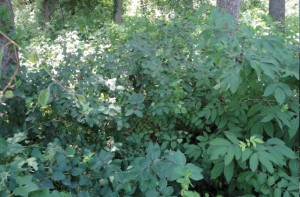Alternatives to Invasive Plants

Here’s the thing about plants that become invasive: They usually start out as a plant someone loves. Buckthorn was hailed as a great hedge plant in the mid 20th century—and it was a nice hedge, except that birds started distributing the seeds all over Minnesota’s wild areas. Now this rogue plant is threatening many native areas.
Awhile back, we received a booklet from the Midwest Invasive Plant Network that suggests alternatives to invasive plants, including some popular garden plants that are threatening native areas. These are plants with the same qualities gardeners are seeking but with less vigorous tendencies.
For instance, Japanese barberry, a hugely popular foundation shrub, has now been classified as invasive. Many barberries produce massive numbers of seeds, which birds spread to native oak habitats, where the shrubs shade out many native species. (Beginning this year, many Japanese barberry cultivars are being phased out of production and will be classified as noxious weeds at the end of 2017.) But, if you want the landscape properties of barberry—nice form and color, ability to hand urban environments—what can you choose instead? How about smokebush, Diabolo ninebark or winterberry holly? Each of those plants has the ability to tolerate urban soil and offers something special in the form of color, leaf shape or a bright berry.
Another example of an easy invasive switch is planting American bittersweet instead of Oriental bittersweet. Each plant has attractive leaves and fruit and the American bittersweet is a native to our area. Ribbon grass is another garden plant that has proven to be just too hardy. If you are looking for a tufted grass, why not try ‘Ice Dance’ carex or autumn moor grass instead?
The booklet is available for 50 cents in a printed form or can be downloaded as an app for your phone for free. It might be just the thing to take with you when shopping for plants this spring.
